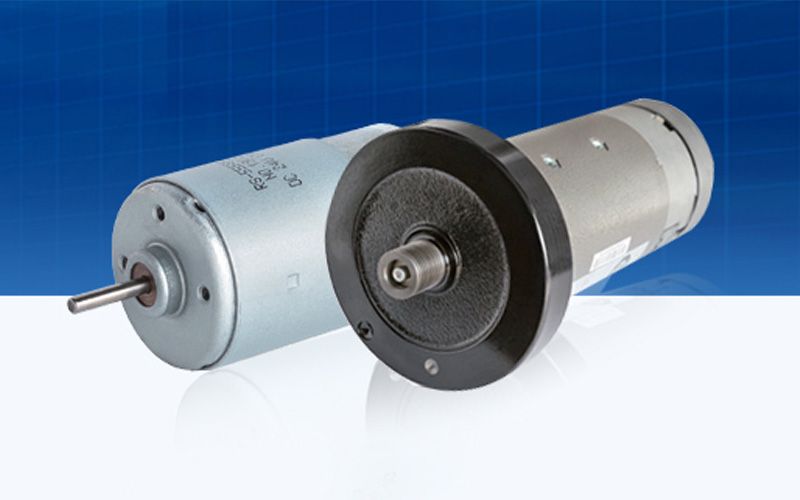Among the most popular electric motors in a variety of sectors, such as consumer appliances, industrial, and automotive, are brushed DC motors. They are particularly favored for their simple design, cost-effectiveness, and ability to provide high starting torque.
There are several methods for controlling brushed DC motors, each offering distinct advantages, and the choice of control method depends on factors such as application requirements, cost, complexity, and performance needs. This article explores four common control methods for brushed DC motors, discusses their advantages and disadvantages, and provides guidance on how to select the right one for your application.

Introduction to Brushed DC Motors
A brushed DC motor (BDC) consists of a stator, rotor (armature), commutator, and brushes. The motor’s operation relies on the mechanical contact between brushes and the commutator, which reverses the current in the rotor windings, generating a rotating magnetic field. This simplicity makes BDC motors suitable for various applications, but it also means that they require specific control strategies to ensure optimal performance, especially in terms of speed, torque, and direction.
Four Common Control Methods for Brushed DC Motors
The control of brushed DC motors typically involves regulating the voltage applied to the motor, which in turn controls the motor’s speed, torque, and direction. The following are four widely used methods of controlling these motors:
- On/Off Control (Switching Control)
- Pulse Width Modulation (PWM) Control
- Analog Control
- Closed-Loop Control (Feedback Control)
On/Off Control (Switching Control)
On/off control, also known as binary or switching control, is the most basic method of controlling a brushed DC motor. It involves applying either a full voltage to the motor or disconnecting it completely from the power supply. This method is typically used in simple applications where precise control over the motor’s speed and direction is not required.
How it Works:
- The motor is either on (with full voltage) or off (no voltage).
- The motor’s operation is controlled by a simple switch or relay, which toggles the power supply to the motor.
- No feedback or modulation of the motor speed is involved.
Advantages:
- Simplicity: On/off control is the simplest and least expensive method, requiring minimal components.
- Cost-Effective: This method requires very little circuitry, making it highly affordable.
- Suitable for Simple Applications: Ideal for tasks that require the motor to be either fully on or off, such as in toys, basic fans, or small appliances.
Disadvantages:
- Lack of Precision: It does not offer any control over speed or torque.
- High Wear and Tear: The motor is either running at full speed or not at all, which can result in stress on the motor and higher wear rates.
Applications:
- Basic toys and gadgets.
- Simple appliances with no variable speed requirements.
Pulse Width Modulation (PWM) Control
By quickly turning the motor’s power source on and off, PWM regulates the average voltage delivered to the motor. The average voltage and, consequently, the motor’s speed and torque are determined by the duty cycle, or the ratio of on-time to off-time.
How it Works:
- The motor power is pulsed at a fixed frequency, and the proportion of time the power is on is varied to control the motor’s speed.
- The pulse’s duty cycle determines the effective voltage. For example, a 50% duty cycle applies 50% of the maximum voltage to the motor.
- The frequency of the PWM signal remains constant, and the motor’s speed is determined by adjusting the duty cycle.
Advantages:
- Efficient Speed Control: PWM allows for efficient control of motor speed without wasting power in resistive losses.
- Improved Torque Control: By adjusting the duty cycle, it is possible to control the motor’s torque output more effectively.
- Reduced Heating: The high switching speed of PWM reduces the heating issues typically caused by resistive losses.
- Low Power Losses: Since the motor is only supplied with the necessary amount of power, PWM reduces power wastage.
Disadvantages:
Complexity: PWM requires additional components like pulse generators and controllers, which adds complexity compared to on/off control.
Electromagnetic Interference (EMI): High-frequency switching may lead to EMI, which could interfere with sensitive electronics.
Applications:
- Robotics and automation.
- DC fans and motors with variable speed control.
- Electric vehicles (EVs) and electric scooters.
- Adjustable-speed pumps and conveyors.
Analog Control
A variable voltage is used in analog control to regulate the brushed DC motor’s speed. By altering the input voltage, the motor’s speed can be changed. This method provides a simple way to control the motor, although it has limitations when compared to PWM control.
How it Works:
- A variable resistor, potentiometer, or voltage regulator is used to adjust the voltage supplied to the motor.
- As the input voltage increases, the motor speed increases proportionally, and vice versa.
- This method is less efficient than PWM because the motor may operate at less than optimal voltage levels for certain tasks.
Advantages:
- Simple Implementation: Analog control circuits are relatively simple and cost-effective.
- Smooth Control: Analog control allows for smooth, continuous speed adjustments without the abrupt transitions of on/off control.
Disadvantages:
- Less Efficient: This method involves wasting power as heat due to resistive losses.
- Limited Control: Analog control doesn’t provide precise, fine-grained speed adjustments or torque control.
- Voltage Dependency: A stable power supply is required to achieve accurate motor control.
Applications:
- Simple speed control applications like electric fans and small electric pumps.
- Applications in which energy efficiency is not a top priority.
Closed-Loop Control (Feedback Control)
Closed-loop control, or feedback control, uses sensors to monitor the motor’s performance and adjusts the input signal accordingly to maintain the desired speed or torque. This approach is more sophisticated than the others since it offers ongoing modifications based on data collected in real time, resulting in motor control that is more precise and dependable.
How it Works:
- A feedback device (e.g., encoder, tachometer, or Hall sensor) is used to measure the motor’s speed or position.
- The feedback is fed back into a controller, which compares the actual speed with the desired speed and adjusts the motor’s input accordingly.
- The controller continuously fine-tunes the power supplied to the motor, ensuring consistent speed or torque under varying loads.
Advantages:
- Precision Control: Closed-loop control allows for precise management of speed, torque, and position.
- Adaptability: The motor can respond to changes in load and external conditions, making it ideal for applications requiring constant performance.
- Increased Efficiency: Feedback systems ensure that the motor operates at optimal levels, minimizing energy waste.
Disadvantages:
- Complexity and Cost: This method requires additional sensors and a more sophisticated controller, leading to increased complexity and cost.
- Power Consumption: The need for additional sensors and circuitry can increase power consumption.
Applications:
- Robots and CNC machines where exact speed and placement are necessary.
- Industrial automation and high-performance applications.
- Automotive applications like power steering and window motors.
Comparison of the Four Control Methods
| Feature | Voltage Control | PWM Control | Armature Resistance Control | Field Control |
| Complexity | Simple | Moderate | Simple | High |
| Efficiency | Low | High | Low | Moderate |
| Cost | Low | Moderate | Low | High |
| Precision | Low | High | Moderate | High |
| Maintenance | Low | Moderate | Low | High |
| Speed Control Range | Limited | Wide | Limited | Wide |
| Heat Generation | High | Low | High | Moderate |
How to Pick the Best Control Technique for Your Use Case
It is crucial to take into account the following elements when choosing the best control strategy for a brushed DC motor:
Application Requirements:
- If your application requires simple on/off control, such as in toys or basic appliances, on/off control may be sufficient.
- PWM control is usually the best option for applications that need precise speed control, like fans or robotics.
- If simplicity and low cost are crucial factors, analog control might be the most straightforward option.
- Closed-loop control is the ideal option for applications requiring a high degree of precision, like industrial robots or CNC machines.
Efficiency Needs:
For applications where energy efficiency is important, PWM control and closed-loop control are preferable, as they provide precise and optimized motor performance.
Complexity and Cost:
For budget-conscious applications where complexity is a concern, on/off control or analog control are cost-effective solutions.
For high-performance applications, closed-loop control is worth the additional investment.
Speed and Torque Control:
PWM control and closed-loop control are ideal for achieving both fine speed and torque control in dynamic environments.
Maintenance and Longevity:
PWM control and closed-loop control are better for applications where the motor will be used continuously, as they improve the lifespan and reduce wear.
Summary
Choosing the right control method for your brushed DC motor depends on the application’s requirements, including the need for efficiency, precision, cost, and complexity. While on/off control is simple and cost-effective, more advanced methods like PWM, analog, and closed-loop control provide finer control over motor speed, torque, and overall performance. By carefully considering the application’s specific needs, you can select the control method that will ensure optimal motor performance and longevity.

